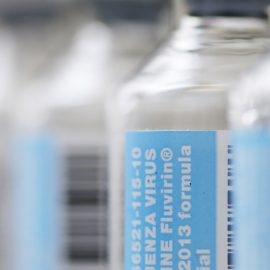About
Vaccines train our body to build immunity against an infectious disease – without causing the disease.
Vaccines introduce antigens into our immune system. Antigens are dead or weakened germs or inactivated toxins produced by the germs.
Once vaccinated, our bodies produce antibodies to combat the germs.
When the immune system faces the real disease producing germ, it will produce antibodies to combat it. Depending on the strength of your immune response and how effectively the antibodies fight off the germ, you may or may not get sick.
How Do Vaccines Work?
Our immune system contains special cells and chemicals that fight off infection known as antibodies. We gain immunity either by naturally catching the disease or by vaccination.
Vaccines are made up of a modified version of disease-causing germs or toxins (known as ‘antigens’). There are vaccines against both viral and bacterial pathogens. Alternatively, mRNA vaccines instruct our cells to stimulate an immune response. Vaccines are usually given by injection or a small drink that contains the vaccine.
Vaccines cause an imitation infection. This type of infection, however, does not cause illness, but it does cause the immune system to generate T-lymphocytes, which in turn produce antibodies.
Vaccines prime your immune system against future “attacks” by a particular disease. If your body is exposed to the same pathogen in the future, it will recognise it and produce antibodies to combat it.
Are Vaccines Safe?
Sometimes, after getting a vaccine, the imitation infection can cause minor symptoms, such as fever. Such minor symptoms are normal and should be expected as the body builds immunity. They usually occur within two days of receiving the vaccine.
Serious side effects are very rare.
Vaccination is a safe way to develop immunity, as naturally catching the disease can cause severe symptoms, complications, hospitalisations and in some cases death.
How Long Do Vaccines Take to Work?
On average, an immune response can take 7 – 21 days.
What Is In Vaccines?
Antigen: the most important part of the vaccine. A modified version of the disease catching germ. Most antigens are parts of germs.
Adjuvants: help strengthen the immune system’s response to the antigens in vaccines.
Stabilisers: stop vaccines from going off.
Preservatives: protect vaccines from becoming contaminated with harmful bacteria and fungi. The most common preservative is a tiny amount of alcohol.
Diluents: water or salt water.
Types Of Vaccines
Vaccines are made using several different processes.
- The whole virus/bacterium approach:
- Inactivated or killed germ: This vaccine uses the whole disease-causing virus/bacterium and inactivates or kills it using heat, radiation or chemicals.
- Live, attenuated approach uses a live weakened version of the virus. It may not be suitable for people with weakened immune systems.
- Viral vector vaccines: This type of vaccine uses a safe virus to deliver specific parts (called proteins) of the germ of interest, so that it can trigger an immune response without causing disease. To do this, the instructions for making particular parts of the germ of interest are inserted into a safe virus. The safe virus then serves as a platform or vector to deliver the protein into the body.
- Subunit approach: This vaccine uses certain parts of the bacterium/virus that the immune system needs to recognise in order to produce an immune response. Many of the childhood vaccines on the National Immunisation Program (NIP) use this approach.
- Nucleic acid vaccine: This vaccine delivers a specific set of instructions to our cells, either as DNA or mRNA, for them to make the specific protein that we want our immune system to recognise and respond to.
| Vaccine Type | Available on National Immunisation Program (NIP) |
|---|---|
| Live, attenuated | Measles, Mumps, Rubella Chickenpox Zoster (Shingles) |
| Inactivated, killed | Polio Hepatitis A |
| Toxoid, inactivated | Diphtheria, tetanus (part of DTPa combined vaccine) |
| Subunit, recombinant, conjugate and polysaccharide vaccines | Hepatitis B Haemophilus type B Pertussis (part of DTPa combined vaccine) Pneumococcal Meningococcal Human Papilloma Virus (HPV) Influenza |
COVID-19 vaccines currently available in Australia
| Vaccine Type | Currently available in Australia |
|---|---|
| Subunit vaccine | Nuvaxovid (Novavax COVID-19 vaccine) |
| Nucleic acid vaccine | Comirnaty (Pfizer mRNA COVID-19 vaccine) Spikevax (Moderna mRNA COVID-19 vaccine) |
| Viral vector vaccine | Vaxzevria (AstraZeneca COVID-19 vaccine) |
References:
- Australian Technical Advisory Group on Immunisation (ATAGI). Australian Immunisation Handbook, Australian Government Department of Health, Canberra, 2018, immunisationhandbook.health.gov.au.
- Department of Health Victoria Better Health Channel, Health, Healthy Living, Vaccines Fact Sheet Reviewed 18Feb22 https://www.betterhealth.vic.gov.au/health/healthyliving/vaccines
- Department of Health Australia, SKAI. What is in vaccines Info Sheet July 2020
- https://www.who.int/news-room/feature-stories/detail/the-race-for-a-covid-19-vaccine-explained
- https://www.historyofvaccines.org/content/articles/different-types-vaccines
